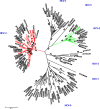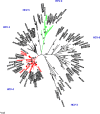Low prevalence of HCV infection with predominance of genotype 4 among HIV patients living in Libreville, Gabon
- PMID: 29385148
- PMCID: PMC5791959
- DOI: 10.1371/journal.pone.0190529
Low prevalence of HCV infection with predominance of genotype 4 among HIV patients living in Libreville, Gabon
Abstract
Background: Gabon is an endemic area for human immunodeficiency virus (HIV) and hepatitis C virus (HCV) and the risk of co-infection is high.
Method: Between November 2015 and April 2016, we conducted retrospective study on HCV infection among people living with HIV/AIDS (PLHA). A total of 491 PLHA were included in this study and tested for the presence of HCV infection. HIV viral loads were obtained using the Generic HIV viral Load® assay and the CD4+ T cells count was performed using BD FACSCount™ CD4 reagents. HCV screening was performed using the MP Diagnostics HCV ELISA 4.0 kit. HCV genotypes were determined by sequence analysis of NS5B and Core regions. The Mann-Whitney test was used to compare the groups. Chi-2 test and Fisher's Exact Test were used to compare prevalence.
Results: HCV seroprevalence was 2.9% (14/491), (95% confidence interval (CI):1.4-4.3%). The percentage of HCV viremic patients, defined by the detection of HCV RNA in plasma, was 57% (8/14), representing 1.6% of the total population. HCV seroprevalence and replicative infection were not statistically differ with gender. The percentage of co-infection increased with age. No correlation with CD4+ T cells count and HIV viral load level was registered in this study. Identified HCV strains were predominantly of genotype 4 (87.5%) including 4k, 4e, 4g, 4p, 4f and 4c subtypes. Only one strain belonged to genotype 2 (subtype 2q). Analysis of the NS5B region did not reveal the presence of resistance-associated substitutions for sofosbuvir.
Conclusion: A systematic screening of hepatitis C is therefore strongly recommended as well as genotyping of HCV strains in order to adapt treatments for the specific case of people living with HIV/AIDS in Central Africa.
Conflict of interest statement
Figures


Similar articles
-
Hepatitis C (HCV) genotype and viral titer distribution among Argentinean hemophilic patients in the presence or absence of human immunodeficiency virus (HIV) co-infection.J Med Virol. 1997 Jun;52(2):219-25. J Med Virol. 1997. PMID: 9179772
-
[The prevalence of hepatitis C virus (HCV) subtypes in Chinese HIV-1/HCV co-infected individuals].Zhonghua Liu Xing Bing Xue Za Zhi. 2009 Jul;30(7):663-7. Zhonghua Liu Xing Bing Xue Za Zhi. 2009. PMID: 19957585 Chinese.
-
High prevalence of hepatitis C virus infection and predominance of genotype 4 in rural Gabon.J Med Virol. 2008 Sep;80(9):1581-7. doi: 10.1002/jmv.21252. J Med Virol. 2008. PMID: 18649323
-
Hepatitis C Virus in mainland China with an emphasis on genotype and subtype distribution.Virol J. 2017 Feb 23;14(1):41. doi: 10.1186/s12985-017-0710-z. Virol J. 2017. PMID: 28231805 Free PMC article. Review.
-
Intermediate hepatitis C virus (HCV) endemicity and its genotype distribution in Myanmar: A systematic review and meta-analysis.PLoS One. 2024 Sep 19;19(9):e0307872. doi: 10.1371/journal.pone.0307872. eCollection 2024. PLoS One. 2024. PMID: 39298388 Free PMC article.
References
-
- Pei R, Grund S, Verheyen J, Esser S, Chen X, Lu M (2014) Spontaneous reactivation of hepatitis B virus replication in an HIV coinfected patient with isolated anti-Hepatitis B core antibodies. Virol J 11: 9 doi: 10.1186/1743-422X-11-9 - DOI - PMC - PubMed
-
- Fabbri G, Mastrorosa I, Vergori A, Mazzotta V, Pinnetti C, Grisetti S, et al. (2017) Reactivation of occult HBV infection in an HIV/HCV Co-infected patient successfully treated with sofosbuvir/ledipasvir: a case report and review of the literature. BMC Infect Dis 17: 182 doi: 10.1186/s12879-017-2287-y - DOI - PMC - PubMed
-
- Modi AA, Feld JJ (2007) Viral hepatitis and HIV in Africa. AIDS Rev 9: 25–39. - PubMed
-
- Rao VB, Johari N, du Cros P, Messina J, Ford N, Cooke GS (2015) Hepatitis C seroprevalence and HIV co-infection in sub-Saharan Africa: a systematic review and meta-analysis. Lancet Infect Dis 15: 819–824. doi: 10.1016/S1473-3099(15)00006-7 - DOI - PubMed
-
- WHO (2016) HIV/AIDS Fact Sheet: available online 05–2017 http://wwwwhoint/mediacentre/factsheets/fs360/en/.
Publication types
MeSH terms
LinkOut - more resources
Full Text Sources
Other Literature Sources
Medical
Research Materials
Miscellaneous

